-
LeetBook新手村题单
一、一维数组动态和
- 题目描述:
给你一个数组nums。数组「动态和」的计算公式为:runningSum[i]= sum(nums[0]···nums[i])。 请返回nums[的动态和。

- 解题思路:
(1)创建一个结果数组,来维护结果集
(2)利用动态和更新给出的数组(原地修改)方法一:
class Solution { public int[] runningSum(int[] nums) { int len = nums.length; int [] sum = new int[len]; sum[0] = nums[0]; for(int i = 1; i < len; i++){ sum[i] = nums[i] + sum[i - 1]; } return sum; } }- 1
- 2
- 3
- 4
- 5
- 6
- 7
- 8
- 9
- 10
- 11
方法二:
class Solution { public int[] runningSum(int[] nums) { for(int i = 1; i < nums.length; i++){ nums[i] += nums[i - 1]; } return nums; } }- 1
- 2
- 3
- 4
- 5
- 6
- 7
- 8
二、赎金信
- 题目描述:
给你两个字符串:ransomNote 和 magazine ,判断 ransomNote 能不能由 magazine 里面的字符构成。如果可以,返回 true ;否则返回 false 。magazine 中的每个字符只能在 ransomNote 中使用一次。

- 解题思路:
(1)利用到了散列表的映射思想,但没用利用其数据结构。创建两个数组,分别记录两个字符串中每个字符出现的次数。两个字符进行算数运算是其对应ASCII码的运算。所以我们利用运算结果来得到数组的索引,共有26个字母所以数组长度应该至少为26,该字符每出现一次将其的值加一,最后如果ransomNote中存在某一个字符出现的次数比magazine中多,则直接返回false,否则返回true。
(2) 对于以上方法的改进,只利用一个数组完成检验,在获取数组下标时不再单独设置两个字符数组,而是利用超级for循环直接完成。- 代码部分:
方法一:
class Solution { public boolean canConstruct(String ransomNote, String magazine) { if(ransomNote.length() > magazine.length()){ return false; } //统计两个字符串中每个字符出现的次数 int [] cnt1 = new int[26]; int [] cnt2 = new int[26]; char [] ch1 = ransomNote.toCharArray(); char [] ch2 = magazine.toCharArray(); for(int i = 0; i < ransomNote.length(); i++){ cnt1[ch1[i] - 'a'] +=1; } for(int i = 0; i < magazine.length(); i++){ cnt2[ch2[i] - 'a'] +=1; } for(int j = 0; j < 26; j++){ if(cnt1[j] > cnt2[j]){ return false; } } return true; } }- 1
- 2
- 3
- 4
- 5
- 6
- 7
- 8
- 9
- 10
- 11
- 12
- 13
- 14
- 15
- 16
- 17
- 18
- 19
- 20
- 21
- 22
- 23
- 24
方法二:
class Solution { public boolean canConstruct(String ransomNote, String magazine) { //magazine的长度小于ransomNote说明肯定其中字符肯定不够组成ransomNote的 if(magazine.length() < ransomNote.length()){ return false; } //判断字符出现次数的数组 int [] count = new int[26]; for (char c : magazine.toCharArray()) { cnt[c - 'a']++; } for (char c : ransomNote.toCharArray()) { cnt[c - 'a']--; if(cnt[c - 'a'] < 0) { return false; } } return true; } }- 1
- 2
- 3
- 4
- 5
- 6
- 7
- 8
- 9
- 10
- 11
- 12
- 13
- 14
- 15
- 16
- 17
- 18
- 19
- 20
三、FizzBuzz
- 问题描述:给你一个整数 n ,找出从 1 到 n 各个整数的 Fizz Buzz 表示,并用字符串数组 answer(下标从 1 开始)返回结果,其中:
answer[i] == “FizzBuzz” 如果 i 同时是 3 和 5 的倍数。
answer[i] == “Fizz” 如果 i 是 3 的倍数。
answer[i] == “Buzz” 如果 i 是 5 的倍数。
answer[i] == i (以字符串形式)如果上述条件全不满足。

- 解题思路:
(1)模拟题,分类判断,利用集合来存储字符串类型的结果。
(2)利用StringBuffer类,简化判断次数(但实际运行速度更慢)- 代码部分:
方法一:
class Solution { public List<String> fizzBuzz(int n) { List<String> list = new ArrayList<String>(); for(int i = 1; i <= n; i++){ if(i % 3 == 0 || i % 5 == 0){ if(i % 3 == 0 && i % 5 == 0){ list.add("FizzBuzz"); }else if(i % 3 == 0){ list.add("Fizz"); }else{ list.add("Buzz"); } }else{ list.add("" + i); } } return list; } }- 1
- 2
- 3
- 4
- 5
- 6
- 7
- 8
- 9
- 10
- 11
- 12
- 13
- 14
- 15
- 16
- 17
- 18
- 19
方法二:
class Solution { public List<String> fizzBuzz(int n) { List<String> list = new ArrayList<String>(); for(int i = 1; i <= n; i++){ StringBuffer sb = new StringBuffer(); if(i % 3 == 0){ sb.append("Fizz"); } if(i % 5 == 0){ sb.append("Buzz"); } if(sb.length() == 0){ sb.append(i); } list.add(sb.toString()); } return list; } }- 1
- 2
- 3
- 4
- 5
- 6
- 7
- 8
- 9
- 10
- 11
- 12
- 13
- 14
- 15
- 16
- 17
- 18
- 19
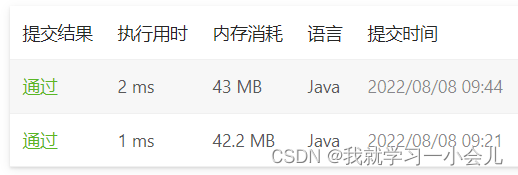
四、链表的中间结点
- 问题描述:给定一个头结点为 head 的非空单链表,返回链表的中间结点。如果有两个中间结点,则返回第二个中间结点。

- 解题思路:
(1) 统计链表中结点的个数,创建一个新的指针初始化为链表头结点,移动(int)( n / 2)次,返回该指针即可
(2) 创建一个结点类型的数组,将链表中的指针保存到数组中,返回数组中的后半部分即可
(3)利用快慢指针,慢指针每次走一步,快指针每次走两步,当快指针到达链表的末尾时,慢指针也到达了链表的中间位置,返回慢指针即可方法一:
/** * Definition for singly-linked list. * public class ListNode { * int val; * ListNode next; * ListNode() {} * ListNode(int val) { this.val = val; } * ListNode(int val, ListNode next) { this.val = val; this.next = next; } * } */ class Solution { public ListNode middleNode(ListNode head) { int len = 0; ListNode h = head; while(head != null){ len++; head = head.next; } for(int i = 1; i <= len >> 1; i++){ h = h.next; } return h; } }- 1
- 2
- 3
- 4
- 5
- 6
- 7
- 8
- 9
- 10
- 11
- 12
- 13
- 14
- 15
- 16
- 17
- 18
- 19
- 20
- 21
- 22
- 23
- 24
方法二:
/** * Definition for singly-linked list. * public class ListNode { * int val; * ListNode next; * ListNode() {} * ListNode(int val) { this.val = val; } * ListNode(int val, ListNode next) { this.val = val; this.next = next; } * } */ class Solution { public ListNode middleNode(ListNode head) { ListNode [] res = new ListNode[100]; int num = 0; while(head != null){ res[num++] = head; head = head.next; } return res[num >> 1]; } }- 1
- 2
- 3
- 4
- 5
- 6
- 7
- 8
- 9
- 10
- 11
- 12
- 13
- 14
- 15
- 16
- 17
- 18
- 19
- 20
- 21
方法三:
/** * Definition for singly-linked list. * public class ListNode { * int val; * ListNode next; * ListNode() {} * ListNode(int val) { this.val = val; } * ListNode(int val, ListNode next) { this.val = val; this.next = next; } * } */ class Solution { public ListNode middleNode(ListNode head) { ListNode slow = head; ListNode fast = head; while(fast != null && fast.next != null){ slow = slow.next; fast = fast.next.next; } return slow; } }- 1
- 2
- 3
- 4
- 5
- 6
- 7
- 8
- 9
- 10
- 11
- 12
- 13
- 14
- 15
- 16
- 17
- 18
- 19
- 20
- 21
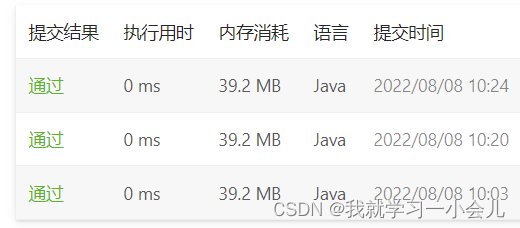
五、将数字变成0的操作次数
- 题目描述:给你一个非负整数 num ,请你返回将它变成 0 所需要的步数。 如果当前数字是偶数,你需要把它除以 2 ;否则,减去 1 。
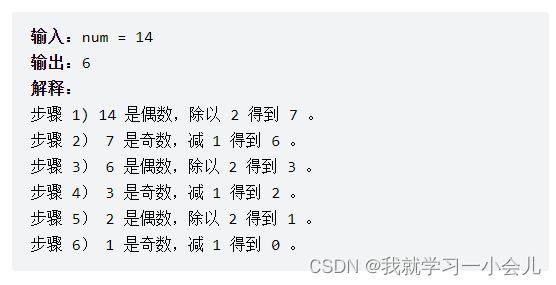
- 解题思路:
利用了最简单的算数运算,也使用了三目运算符针对不同的情况采取不同的方法
- 代码部分:
class Solution { public int numberOfSteps(int num) { int count = 0; while(num != 0){ num = num % 2 == 0 ? num >> 1 : num - 1; count++; } return count; } }- 1
- 2
- 3
- 4
- 5
- 6
- 7
- 8
- 9
- 10
六、最富有客户的资产总量
- 问题描述:给你一个 m x n 的整数网格 accounts ,其中 accounts[i][j] 是第 i 位客户在第 j 家银行托管的资产数量。返回最富有客户所拥有的 资产总量 。客户的 资产总量 就是他们在各家银行托管的资产数量之和。最富有客户就是 资产总量 最大的客户。
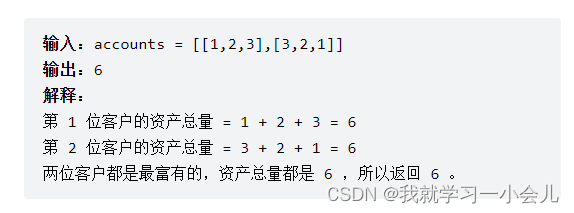
- 解题思路:
(1) 双层for循环,不断更新最大的资产总量
(2)第二版:利用到了Java的流运算,直接将数组求和
Arrays.stream(account).sum();- 代码部分:
方法一:
class Solution { public int maximumWealth(int[][] accounts) { int maxNum = 0; for(int i = 0; i < accounts.length; i++){ int count = 0; for(int num : accounts[i]){ count += num; } if(count > maxNum){ maxNum = count; } } return maxNum; } }- 1
- 2
- 3
- 4
- 5
- 6
- 7
- 8
- 9
- 10
- 11
- 12
- 13
- 14
- 15
方法二:
class Solution { public int maximumWealth(int[][] accounts) { int maxNum = Integer.MIN_VALUE; for(int [] arr : accounts){ maxNum = Math.max(maxNum, Arrays.stream(arr).sum()); } return maxNum; } }- 1
- 2
- 3
- 4
- 5
- 6
- 7
- 8
- 9
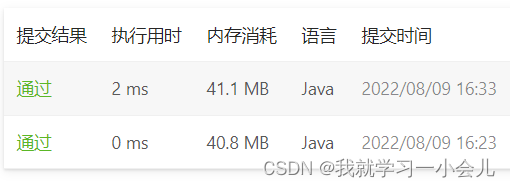
结果说明:使用流运算并不快 - 题目描述:
-
相关阅读:
高效管理企业固定资产的办法
11.5MyBatis(进阶)
最近Intelli Idea官方2023
Address already in dse_JVM_Bind。端口莫名被占用【占用8080端口!!!】
JavaScript【静态方法、实例方法/to类、实例方法/get类、实例方法/set类、Math与Date实操、 JS时间戳、日期互相转换】(九)
[Cortex-M3]-3-分散加载文件解析(.sct)
mysql 字段用了关键字, 无法插入更新数据
【Linux】Linux常用命令—文件管理(上)
基于 OpenMLDB 的联邦学习方案被国际数据挖掘学术会议 CIKM 录取
深度学习_9_图片分类数据集
- 原文地址:https://blog.csdn.net/qq_61323055/article/details/126205875
